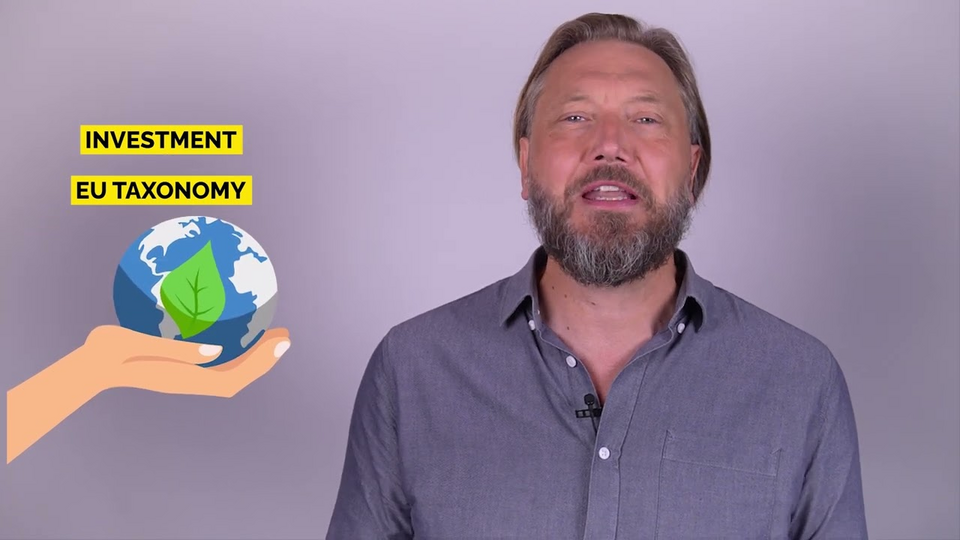Understanding the EU Taxonomy
Data protection notice
When you play our YouTube/Vimeo videos, information about your use of YouTube/Vimeo is transmitted to the operator in the USA and may be saved.

Sustainable investing has rapidly gained popularity in recent years, as more people look for ways to align their finances with their environmental and social values. However, despite this growing interest, the field has been plagued by confusion and inconsistency over what qualifies as "sustainable." Fortunately, the European Union has developed a game-changing initiative that brings clarity to this issue: the EU Taxonomy.
This initiative sets a unified definition of environmentally sustainable activities, making it easier for investors to distinguish between genuine eco-friendly projects and those merely masquerading as "green." But what exactly is the EU Taxonomy, and why is it so important? Let’s dive in.
What Is the EU Taxonomy?
The EU Taxonomy is essentially a classification system that identifies which economic activities are truly sustainable. Think of it as a kind of compass for sustainable investing, guiding investors toward companies and projects that positively impact our environment based on the EU’s established climate and environmental objectives.
Six Key Environmental Goals
The EU Taxonomy is built around six key environmental objectives:
- Climate Change Mitigation
- Climate Change Adaptation
- Sustainable Use and Protection of Water and Marine Resources
- Transition to a Circular Economy
- Pollution Prevention and Control
- Protection and Restoration of Biodiversity and Ecosystems
Each of these objectives has clear, science-based criteria that define what qualifies as a "sustainable" activity. By setting these guidelines, the Taxonomy aims to separate genuine sustainability efforts from superficial initiatives—commonly known as greenwashing.
What Makes an Activity “Environmentally Sustainable”?
For an economic activity to be classified as environmentally sustainable under the EU Taxonomy, it must meet two key requirements:
- Substantial Contribution: The activity must make a significant positive contribution to at least one of the six environmental objectives.
- Do No Significant Harm: The activity must not cause significant harm to any of the other five environmental goals.
Moreover, it must also respect international human and labor rights. This “Do No Significant Harm” principle ensures that while pursuing one environmental goal, activities don’t inadvertently create problems in other areas.
Where Are We Today? Current Focus and Challenges
Currently, the EU Taxonomy is fully developed only for the first two objectives: climate change mitigation and climate change adaptation. The criteria for the remaining four objectives—such as water conservation and biodiversity—are still being finalized and will be introduced in the near future.
Because of this partial implementation, most existing sustainable financial products focus heavily on climate-related goals, leaving a gap in offerings for other critical environmental concerns. As a result, retail investors may find it challenging to support projects that prioritize goals like pollution control or circular economy principles through conventional financial products.
Challenges for Businesses and Investors
The Taxonomy is already shaping the finance industry by setting a high bar for sustainability. However, this also presents some challenges, particularly for businesses in heavy industries. For these companies, aligning with the Taxonomy criteria may require significant investments in new technologies and processes, which could take years to implement.
This means that while the Taxonomy is a powerful tool for promoting sustainability, it also highlights the need for a gradual transition in certain sectors. Businesses and investors need to be patient and committed to long-term change.
The Impact on Retail Investors
For individual investors, the EU Taxonomy brings a welcome dose of transparency and accountability. By aligning their portfolios with the Taxonomy, retail investors can be confident that they are supporting activities that are genuinely contributing to a sustainable future.
However, it’s important to note that many financial institutions are still in the process of developing products that allocate a substantial portion of investments to Taxonomy-aligned activities. This means retail investors might need to actively seek out products that go beyond climate goals and encompass a broader range of environmental objectives.
What Can Retail Investors Do?
Retail investors should use their influence to demand more comprehensive sustainable products that address all six environmental objectives, not just climate change. While this might seem like a tall order, consumer demand is a powerful driver of change. By voicing their preferences, investors can push the market to develop more inclusive products that better align with the full scope of the EU Taxonomy.
The Bottom Line: A Guiding Star for Sustainable Finance
The EU Taxonomy isn’t perfect, and it’s not without its challenges. But it’s a crucial step forward in the journey toward truly sustainable finance. By providing a clear and consistent framework, it brings transparency to the market and helps investors avoid greenwashing.
In essence, the Taxonomy serves as a guiding star for directing capital toward activities that have a genuine positive impact on the environment. As the criteria for more environmental objectives are rolled out, the Taxonomy will continue to evolve, offering even greater opportunities for investors to make a meaningful difference.
So, now that you have a clearer view of what the EU Taxonomy is and how it works, why not explore further? Stay informed, and continue learning how to make your investments truly count for a sustainable future!
(Written with the assistance of Chat GPT.)

Comments
No Comments